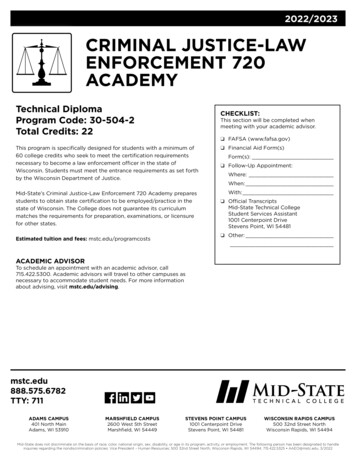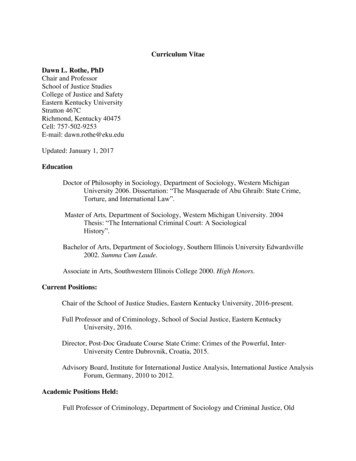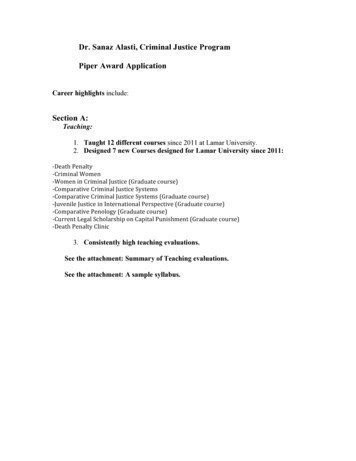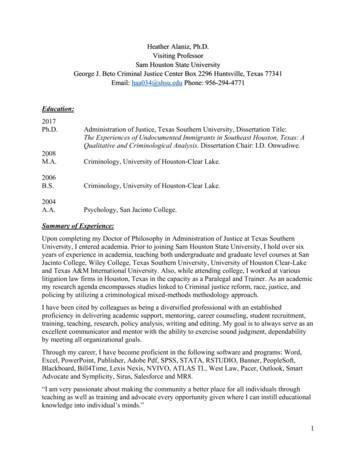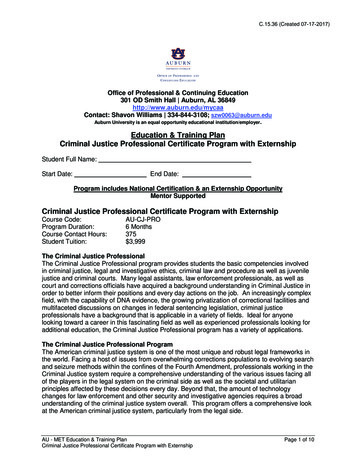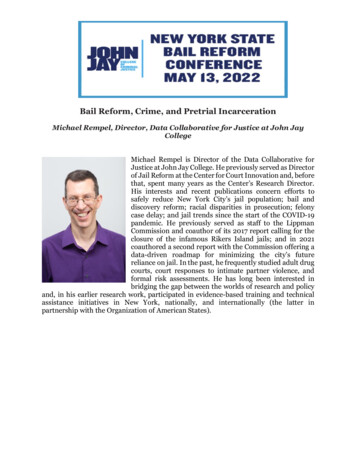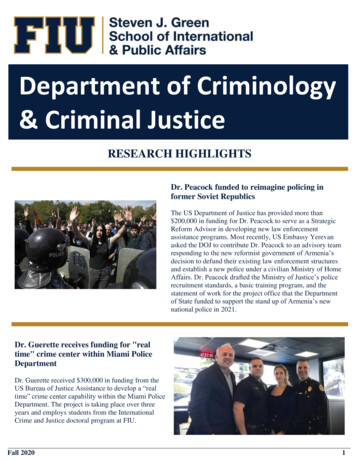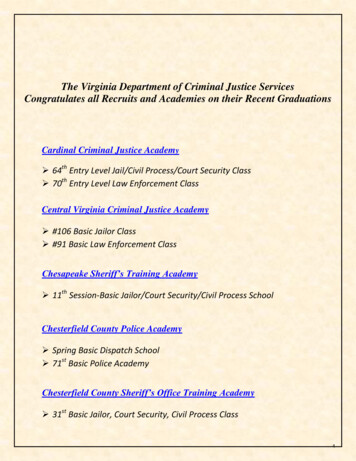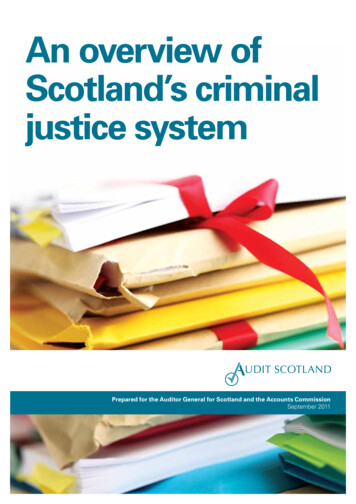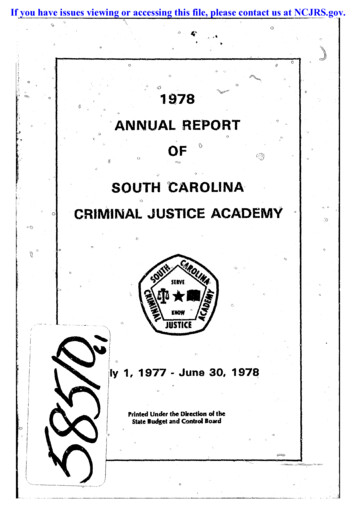
Transcription
If you have issues viewing or accessing this file, please contact us at NCJRS.gov.o.oBo1978'ANNUAL RE'PORToOF(IC oSOUTH CAROLINAoCRIMINAL JUSTICE ACADEMYII 1, 1977 - June 30,1978I!Prinfed Under the Direction of theStale Bqet arid control Board o
1978ANNUAL REPORTOFSOUTH CAROLINACRIMINAL JUSTICE ACADEMYNCJRSJuly 1, 1977 - June 30, 1978Printed Under the Direction of theStite Budget ind Control BOird
TABLE OF CONTENTSPagePurpose .:1 , , ,.3Organizational Chart . 4Law Enforcement Council. . . . . . . . . . . . . . . . . . . . . . . . . . . . . . . . 5Administration. . . . . . . . . . . . . . . . . . . . . . . . . . . . . . . . . . . . . . . . . . 7History, 1968·1978 . . 8Academy Facility . 9Driving and Firing Ranges . , . . 10Instructors . 11Law Enforcement Training . 151977·78 Law Enforcement Award Winners . 16Law Enforcement Course List . 17Map of S. C. Basic Training . 18Correctional Training . 19Judicial Training . 19Income . , .I 20Expenses . . 201977··78 Expenditures . 21Federaliy Funded Programs forLaw Enforcement Training . . 21Publications . . 22Current Status . ". 22
3PURPOSEThe purpose of the Academy, as defined by the law which created it(Act #1186 R. 1358, Sections 23-23-40 fL, S. C. Code of Laws),is toupgrade criminal justice by establishing selection standards andproviding a unified training program for law enforcement personnelwhile maintaining instructional facilities for the other branches ofcriminal justice (judicial and correctional). To fulfill this objective,the act provided for a central training facility, an eleven-mefl.lbergoverning council to formulate policies, and a system supported bypenalty assessments to finance operational costs. To insure statewideparticipation by law enforcement personnel, the act mandatedcertification (which requires basic training) for all law enforcementofficers hired after January 1,1972 by departments employing morethan four full-time officers or located in towns having populationsgreater than 2,500.The act has been amended several times-in 1971 to add onemember (FBI Special Agent in Charge) to the Training Council andto make the financing system permanent; in 1974 to provide for aLaw Enforcement Hall of Fame to be erected 'and operated inconjunction with the Academy; in 1976 to reduce from 10 years to fiveyears the time prior to employment during which there should benoconviction for D.V.I. or Leaving Scene of Accident. An amendmentproposed for the 1978-79 fiscal year was passed, effective July 1,1978,which (1) eliminates exemptions from training for police chiefs, (2)eliminates exemptions from basic training for officers of smalldepartments, and (3) raises the rate of penalty assessments.On July 12, 1978, an act took effect providing for the appointment of Reserve Police Officers by department chiefs. Beforeassuming their duties these reserve officers shall: (1) Take the oath or'office as required by law, (2) Be bonded, in an amount determined bythe governing body of the county, municipality or other politicalentity which shall be 'not less than 1,500 and (3) Successfullycomplete a course of training specified by the S.C. Law EnforcementTraining Council and endorsed by the chiefs who appoint them.South Carolina Criminal Justice Academy is setting new trends irrtraining. Here, instruction is offered for personnel in all three realmsof criminal justice-in law enforcement, in which violators areremoved from society; in judicial, in which they are tried andsentenced; and in correctional, in which they are prepared for returnto society. This system of training has brought national recognitionto the Academy and to South Carolina as well.
SOUTH CAROLINA CRIMIr-.JAL JUSTICE ACADEMYORGANIZATIONAL CHART[LAW ENFORCEMENT TRAINING COUNCILIIEXECUTIVE DIRECTOR-IDEPUTY DIRECTORDIRECTOR OF TRAININGSTAFF DEVELOPMENT & TRAININGASSIST ANT DIRECTOR
5SOUTH CAROLINA LAW ENFORCEMENTTRAINING COUNCILBy law, the Training Council is composed of representatives fromthe following governmental agencies-county administration, cityadministration, the University of South Carolina Law School (dean),Department of Wildlife and Marine Resources, courts (AttorneyGeneral), Department of Corrections, two officers from state policedepartments, and one representative from each of the followingdepartments: small town police, large'city police, federal police, andsheriff department.CURRENT MEMBERSJ. P. Strom, ChairmanChief, South Carolina Law Enforcement DivisionL. Edward Simmons, Vice-ChairmanChief, North Charleston PDJames AndersonMayor, CamdenJ. P. AshmoreSupervisor, Greenville CoUntyCharles F. DawleyChief, Mount Pleasant PDRichard E. DayDean, USC Law SchoolCharles J. DevicSpecial Agent in Charge, FBI, ColumbiaWilliam D. LeekeCommissioner, SC Department of CorrectionsDaniel R. McLeodAttorney General of South CarolinaJames R. MettsSheriff, Lexington CountyWilliam J. SeabornColonel, South Carolina Highway PatrolJames A. TimmermanDirector, SC Wildlife and Marine Resources
6FORMER MEMBERSRichard L. BlackCounty Magistrate, Charleste,l1James J. DunnSpecial Agent in Ch:.trge, FBI, ColumbiaRobert H. EppesTemporarily filled county positionRobert W. FosterDean, USC Law SchoolMiller S. IngramMayor, CherawWilliam T. lv('yDirector of Law Enforcement, SpartanburgTom W. LeavittSpecial Agent in Charge, FBI, ColumbiaJoseph J. LoefflerSpecial Agent in Charge, FBI, ColumbiaJames F. MartinSpecial Agent in Charge, FBI, ColumbiaI. Byrd ParnellSheriff, Sumter CountyCharles M. SkipperChief, Marion PDHarold C. SwansonSpecial Agent in Charge, FBI, ColumbiaP. F. ThompsonColonel, South Carolina Highway PatrolJames W. WebbDirector, SC Wildlife and Marine Resources
7ACADEMY ADMINISTRATIONExecutive Director . Clifford A. MoyerDeputy Director . Paul A. MillerDirector of Training . , William E. JonesStaff Development &Training Assistant Director . Harry C. LoganAccountant . C. Dorothy HarrellAdministrative Assistant . Barbara A. BloomAudiovisual Specialist . Richard A. ShealyCertification . Joyce N. Wrigh tFood Services . Hazel KirkleyMaintena'lce . Charles R. JohnsonTRAINING DIRECTORSLAW ENFORCEMENT AGENCIESS. C. Highway Patrol . Capt. L. F. McSwainS. C. Wildlife & MarineResources Dept. . . Lt. J. Wallace HippsCORRECTIONAL AGENCIESADMINISTRATIONDirector of Staff Development,Department of Corrections . W. Tommy CaveTraining Coordinator,Department of Youth Selvices . Betty GurnellDirector of TrainingProbation, Parole & Pardon Board . Edward FordJUDICIAL EDUCATION ADMINISTRATIONAssistant Director,Courts Administration . Neal Forney.
8HISTORY, 1968-19771968 marked the beginning of law enforcement training in SouthCarolina. That year, the state legislature appropriated 30,000 toSLED for the estahlishment of SOlTTH CAROLINA POLICEACADEMY under the direction of FBI veteran Clifford A. Moyer. Afour-week basic law enforcement training program began and washeld at SLED with a storage area serving as a cla! sroom and a formervenereal disease clinic serving as a dormitory. This 30-studentarrangement soon proved to be inadequate, so in 1970, the law waspasseo that created SOUTH CAROLINA CRIMINAL JUSTICEACADEMY.The construction of the 2.2 million dollar Academy was financedby state and federal funds: the latter were provided by LEAP and theHighway Safety Program. At present, the Academy can sleep 186persons and seat 350 students in classrooms. Facilities also include acafeteria and dining room adjoining a reading lounge equipped withtwo color TV's and billiards, a library, a training tank, and agymnasium complete with body-building equipment.Classes began in 1972 at the present academy site. Because fourweeks of basic law enforcement training was insufficient, plans weremade and carried out to increase the program to 5 weeks in 1971, to 6weeks in 1973, to 8 weeks in 1975, and to 10 weeks in 1978. TheTraining D ivi ion of the S. C. Department of Corrections moved intothe Academy in 1972 and has held its instructional programs hereever since. The Probation, Parole, and Pardon Board, theDepartment of Youth Services, Juvenile Placement and Aftercare,and the Judicial Education program also conduct their trainingsessions at the Academy. Similarly, the S. C. Wildlife and MarineResources Department and the S. "C. Highway Patrol carryoninstructional programs regularly at the Academy.The Academy has developed various training aids to insure wellrounded criminal justice preparation for its students. To assiststudent in coping with future law enforcement situations, a job.related obstacle course is now encountered by each trainee. Since 1974a precision driving range, 1.3 miles in length, has been used forseveral areas of officer training. During fiscal year 1977-1978. aclassroom and repair garage were added to the range site, whichpresently includes three mock-up rooms of an ordinary home, whereCrisis lntervention problems are practiced. A small log cabin bankbuilding, also located at the range, was donated to the CriminalJustice Adademy during 1976. It is used in simulated robberies,
9burglaries, hostage situations, and other offenses. In addition to theprecision c1:iving range, the Academy also operates a 50 firing pointpistol range, with a classroom and target sforage area.lOAO . ODOCK.IUI" " . IIII I-"t.;.-r,., I UIT':'!-:Itrr' fAOMJNlhUIiOH-, l . L l'--;"""""-ACADEMY FACILITY
------------- 'MGlT tiNE ------------------ ----- ---------M s-------------- ------ ym---------------- io ------ ym-------------- -- 1.3 MI. TNNKBLEACHERSINSTRuaOR'S rOWERI. II-'opmlNGDRIVING RANGEFIR.fNG RANGE
---------------.'11INSTRUCTORSPhillip S. Allen-Law Enforcemenl2 years, Palmer College; 2nd Class Petty Officer, U.S.N.R.; 4years,Columbia Police Department; joined Academy staff in 1974; primaryteaching areas-Breathalyzer, Metric System, and DUI ArrestProcedures; member, Dutch Fork Masonic Lodge #402.James H. Amick, Lt.-S.C.H.P.3 years, Uniled States Marines;. 25 years law enforcementexperience; joined Criminal Justice Academy staff in 1972 from theS.C. Highway Patrol Headquarters; Serves in the capacity of Headinstructor; primary teaching area-Police Officer Driving TrainingProgram.Bobby E. Benson-S.C.D.C.B.S., Elementary Education, Morris College. Sumter; 2 years, U.S.Army; One year, public school teacher; 2 years, correctional andonthe-job training officer, S.C.D.C.; Vocational instructor assignedto the Criminal Justice Academy in September 1973.Becky L. Boatman-Law EnforcementB.S., Criminal Justice, Honor graduate, Delta State University,Miss.; One year in law enforcement; joined Academy staff in 1976 asRecreation Specialist; promoted to Instructor, 1977; primaryteaching areas-Water Safety, First Aid, CPR, PoliceCommunications; Police Practical Problems; U.S.c.; featured in1976-77 Personalities of the South, 1977-78 International Who's Whoin Community Service.Samuel J. Breci-Law EnforcementLaw degree, Creighton University Law School, Omaha, Nebraska;Special Agent, F.B.I., 1952-76; Fingerprint instructor since 1970;joined Academy staff in 1976, primary teaching areasFingerprinting, Crime Scene Searches, Collection and Preservationof Evidence; member, Nebraska State Bar Association.Israel Brooks, Jr.,Sgt.-S.C.H.P.Associate degree, Palmer College; 4 years, U.S. Marines; joined S.C. State Police as 1st black patrolman in 1967; recognized asPatrolman of the Year, 1973, by American Legion, S.C.H.P., andVeterans of Foreign Wars; joined Academy staff in 1976; CertifiedBreathalyzer Operator; primary teaching areas-Human Relations,
12Police Gommunity Relations, Uniform Traffic Citation, Felony CarStops, Precision Driving.W. Bruce Cann, Sgt.-S.C.H.P.Associate degree, Police Administration, Midlands TechnicalCollege; 4 years, United States Navy; appointed to South CarolinaHighway Patrol in 1965; joined Academy staff in 1973; primaryteaching area-Police Self-Defense Instructor.Bruce H. Carter-Law EnforcementAssociate and B.G.S. degrees, U.S.C.; 8 years, United StatesMarines; U.S.M.C. weapons instructor; joined Academy staffparttime, 1972; full-time instructor upon graduation in 1974;primary teaching areas-Firearms, Felony Car Stops, CrisisIntervention; Presently enrolled in Graduate School in PublicAdministration, U.S.C.Leon G. Cureton-Law EnforcementB.A. degree, Allen University, Columbia, S'.C.; three years in lawenforcement with Lancaster Police Department as Detective andPublic Relations Officer; joined Criminal Justice Academy staff,July, 1978; primary teaching areas-Driving Range Instructor,Human Relations Instructor.John A. Ferraro-S.C.D.C.B.S. and M.S. degrees, University of Maryland, University ofKentucky, and U.S.C.; Instructor at Southeastern Signal Schoolwhile in United States Army; joined Academy staff as S.C.D.C.Instructor in 1976; primary teaching areas-InterpersonalCommunications/ Human Relations Workshops.Richard A. Flippo-Law EnforcementB.A. degree, U.S.C.; several law enforcement related schools; 3years as Deputy Sheriff, Lexington County Sheriff's Department;joined Academy staff in 1977; primary teaching areas-PrecisionDriving, Techniques of Arrest, Patrol Procedures & InterviewTechniques, Felony Cal' Stops, Handling Prisoners, Firearms, PolicePractical Problems.Gordon A. Garner-S.C.D.C.Erie County Technical Institute, New York, F.B.1. NationalAcademy, Washington, D.C.; various other law enforcementr:elatedschools; 17 years law enforcement experience; 3 years U ni ted StatesMarines; joined Academy staff in 1978; primary teaching areas-
13Defense Tactics, Weapons, Law of Arrest, Officer Responsibility,Hostage Situations, Narcotics, Riot Control.James B. Hicklin-Law EnforcementB.A., U.S.C.; numerolls law enforcement schools; 8 years, LawEnforcement Officer and Supervisor; 3 years, Instructor, Weaponsand Law Enforcement su bjects, S.C.D.C.; joined Criminal JusticeAcademy staH in 1975; primary teaching areas-Weapons, HostageSituations, Practical Problems.Lendo1 C. Hicks, Jr.-Law EnforcementB.A. from the Citadel, 1971; M.A. from U.S.C. in 1973; RichlandCounty Deputy Sheriff from 1975 until joining staff at the CriminalJustice Academy in May, 1978; Primary teaching areas-Narcotics,Firearms, Physical training, and Defensive Tactics.Lyn Isbell-Recreation Specialist (part-time)1978 graduate from U.S.C. with a B.A. in English, minor inhistory; American National Red Cross Volunteer; Water SafetyInstructor; Multi-media First Aid Instructor; Modular and B.L.S.C.P.R. Instructor; Joined Criminal Justice Academy staffin Januaryof 1978.M. Bruce Jernigan-Law EnforcementB.A. degree, Columbia Commercial College; 14 years with WestColumbia Police Department as Lieutenant; Police trainingatF.B.I.Academy, Virginia; Ohio Peace Officer's Training Academy;Vocational Instructor with Ohio State Dept. of Education in policemalters; joined Academy staff in 1978; primary teaching areasNotetaking and Study Habits, History of Law Enforcement, Ethicsand Professionalization, Report Writing, Handling Juveniles,Police Corruption.Nancy Carroll King-Law Enforcement (part-time)Attended Austin Peay University, Tennessee; National Red CrossAquatic School, Massachusetts; various other educationalinstitutions; Former teacher in Greenwich public and privateschools; Member of National Red Cross Aquatic and Small CraftSchools faculty; Emergency Medical Technician; teaching areaswater safety, CPR, advanced first aid; joined Academy as part-timeinstructor in 1972.James M. Kirby-Law EnforcementJ.D., Mercer University, 1956; post-graduate, St. John's U, 1960;
11Special Agent, FBI, 1953-1977; joined Academy staff in 1978 as aLegal Instructor; member of the South Carolina Bar Association.Robert A. Milam, III-Law EnforcementB.S. and M.S. degrees, U.S.C.; IOyears, Chemist/Instructor/Agent,S. C. Law Enforcement Division; joined Academy staff in 1972;primary teaching areas-Breathalyzer, metric system, DUI arrestprocedures; featured in 1976 Who's Who in the Southeastern UnitedStates.John O'Leary, J.D.-Law EnforcementB.A. degree, Citadel Military College; J.D., University of Detroit;PLA Certification., Northwestern University; joined Academy staffin 1973 as a Legal Instructor; member oftheState Bar Associations ofMichigan, Florida, and S. C.Joseph Ready, Sr., Lt.-Judicial (part-time)Attended special courses at University of Tennessee, TrafficInstitute Northwestern University; Retired South Carolina HighwayPatrol Officer as Lieutenant; joined Criminal Justice Academy staffin 1975; primary teaching areas-Accident Investigation, CourtProcedure.Willard J. Sohn-S.C.D.C.B.A. degree, U.S. C.; joined S.C.D.C. as a Correctional Officer in1971; promoted to present po:.ition, Staff Developer Trainer, in 1972;involved in all phases of Human Resource efforts for S.C.D.C. at theAcademy; Member of American Society for Training andDevelopment, American Association of Correctional Trainers,World Future Society.
15LAW ENFORCEMENT TRAININGThe Minimum Training Standards Act of 1970 requiredcertification of aU law tlnforcement officers hired after January I,1972. This act, which exempted officers of small departments, wasamended by the 1977-1978 legislature to require basic training for allofficers hired by these small departments after January 1, 1978. Thelaw also established selection standards, specifying that a lawenforcement officer must. , .-present a birth certificate proving that he is at least 21 years old-have a high school diploma or GED certificate-pass a physical examination-pass a driver's license check proving that he has not beencon victed of driving under the influence. of alcohol or drugs, orleaving the scene of an accident within the last five (5) years.-pass a background check which includes proof that he has neverbeen convicted of a felony and has a satisfactory credit rating-pass basic trainingBasic training currently consists of ten weeks of instruction, whilebasic highway patrol training is an eleven week program. Studentsare instructed in more than 60 su bject areas through classroomlectures, and various practical eXl"rcises on the firing and drivingranges to insure thorough, realistic training. Law Enforcementstudents must also demonstrate their abilities through variousproficiency tests, which demand competence in such areas asSearching and Handcuffing, Handling Juveniles, CourtroomProcedure, Traffic Citations, Handgun Safety, etc.Graduation ceremonies are held at the end of each basic trainingprogram. Special guest speakers are featured at the ceremonies. In thepast these have included governors of the state, F.RI. agents,senators: mayors, U.S. Marshals, deans and presidents of variousuniversities, personnel 'of many law enforcement agencies, leaders ofthe business community, and numerous elected officials.Performance points accumulated from quizzes and exercises aretallied at the end of each basic training period. The student havingthe highest overall total is recognized during graduation as thewinner of the J. P. Strom Award. Based on scores from the firingrange, students are rated as Marksman, Sharpshooter, or Expert, withthe top shooter recognized during graduation ceremonies.Certificates are distributed at the end of the ceremony, which isattended by students' families and department heads.
161977-1978 LAW ENFORCEMENTAWARD WINNERSBasic Class 0·78J. P. StromWinnerTerry B. ChristyGreenville POJoseph M. BustosCharleston POCharles T. CabanissRock Hill PODaniel P. JohnsonSpartanburg Co. SOWilliam E. SchaekelS.L.E.O.James J. DykesRock Hill POThomas W. ConleyCharleston POGerald L. McCrackenRock Hill POEmanucl R. Bail'Columbia POThomas M. SeiglerGreenville Co. SOJohn O. MatthesChesterfield Co. SODavid C. ChristensenAiken POJerry E. CiementAbbeville PODonald J. Murphy, Jr.Forest Acres POMichael A. SmithSpartanburg Co. SOArnold E. Hoskins, Jr.Charleston City POJames S. KinesMyrtle Beach POHighest PistolScoreMichael E. CromerManning POJesse E. Scott, Jr.S.C. WildlifeEdw:lrd H. McConnellSpmtanburg Co. SOFrank M. DobbsAnderson Co. SOWilliam E. SchaekelS.L.E.O.Silas I. ROland, Jr.Lexington Co. SOJohn T. OwenGreenwood PDThomas M. HarterGrt'Cnville POJamcs T. KingAnderson Co. SOEverette L. Price, Jr.Newberry PORandal L. ShelleyAiken POGerald C. HutchisonS.C. WildlifeRichard A. AdamsWest Columbia, POCharles G. HallGreenville Co. SOMadison C. ThornhillCharleston City POClark H. RoweWest Columbia PORobert L. FlynnCharleston PO .
17Many short courses are offered in specialized fields for lawenforcement officers who have been previously certified. Thoseoffered since 1971 have included the following:Accident InvestigationAdvanced Police PhotogiaphyArson InvestigationBasic FingerprintingBasic Police PhotographyBomb SchoolBreathalyzer CertificationBrenthaIY1.el· Re-certificationChild Abuse SeminarCommunicationsConstable TrainingCrime PreventionCrime Prevention Seminar for LawEnforcement & the Older Americ lnCrowd Control SeminarDetective InvestigationExecutive DevelopmentFirearms Instructor TrainingHighway Patrolln-Servicr TrainingHomicide InvestigatioilLatent FingerprintingNarcotics InvestigationNew Sheriff's WorkshopPolice In-Service TrainingRadar TrainingReserve 0 fficer CertificationSchool for SergeantsSex Crimes SeminarSpecial Basic for Parks,Recreation, & TourismSupervision/ManagementTraffic InvestigationWildlife In-Service TrainingWildlife Scuba Cours The following law enforcement courses were held at the Academyduring the fiscal year 1977-1978:ClassNo. Times OfferedAdvanced Photography. . . . . . . . . . . . . . . . . . . . . . . . . 1Basic Training . ; . 14Basic Fingerprint . ,. 2Basic Photography. . . . . . . . . . . . . . . . . . . . . . . . . . . . . . . . . 7Breathalyzer Certification . 15Breathalyzer Re-Certification . 13Comlnunications . . 4Crime Prevention . . 3.Detective. . . . . . . . . . . . . . . . . . . . . . . . . . . . . . . . . . . . . 7Drug Seminar . . . . . . . . . . . . . . . . . . . . . . . . . . . . . . . . 1Executive Development. . . . . . . . . . . . . . . . . . . . . . . . . . 2Highway Patrol B&sic Training . . . . . . . . . . . . . . . 2Highway Patrol In-Service. . . . . . . . . . . . . . . . . . . . . . . . . . 2Latent Fingerprint . . . . 2Law Enforcement In-Service . 6Law Enforcement Instructor Training'Seminar . 1Radar Training . . . . " 4Traffic Investigation . . . . . 1Wildlife In-Service. . . . . . . . . . . . . . . . . . . . . . . . . . . . 7A total of 2600 seats were filled in law enforcement classes duringthe fiscal year 1977-1978.
18LAW ENFORCEMENT OFFICERS RECEIVINGBASIC TRAINING AT THE CRIMINAL JUSTICE ACADEMYFiscal Year 1977·1978This does not includeofficers receiving specializecriminal justice training or100 Highway Patrol officers whocompleted Basic Training duringfiscal year 1977-197B.
19CORRECTIONAL TRAININGPersonnel of three slate correctional agencies train at theacademy-the Department of Youth Services, the Department ofCorrections, and the Probation, Parole, and Pardon Board. Theacadern/ provides classrooms, housing, meals, and audiovisualequipment for numerous statewide instructional programs for theDepartment of Youth Services. Some of the programs offered arebasic orientation, first aid training, drug education, youth counselortraining, supervisory and management skills, communication skills,defensive driving, secretarial programs, and workshops held inconjunction with other state departments of youth services.The Department of Corrections conducts its training programsand houses its instructional administration at the academy. Thisagency offers many specialized courses in addition to orientation,basic correctional officers' training, and in-service training. Allemployees of the South Carolina Department of Corrections mustattend the one-week orientation prior to assuming their positionswith the agency. After on-the-job instruction, security personnelreturn to the academy to receive basic correctional officers' training.Thereafter, officers must annually attend in-service training whichdeals primarily with firearms instruction. For supervisors, twophases of instruction are offered. Phase I is a pre-requisite forpromotion while Phase II is for all supervisors and concentrates onskill develop men t in specialized areas. Other workshops are held on aregular basis for different groups of correctional personnel.The South Carolina Probation, Parole, and Pardon Board holdsin-service training programs for its personnel. These workshopscover various areas of probation and parole supervision. 1978 willmark the beginning of certification training for personnel of thisagency.During the 1977-1978 fiscal year, 1,104 seats were filled incorrectional classes at the academy.JUDICIAL TRAININGWithin the realm of judiciai training, magistrates, municipaljudges, county judges, and family court judges attend instructional seminars at the academy periodically. These workshops areconducted by the Judicial Education Staff of the CourtAdministrators Office.A total of 671 seats were filled in j udida I seminars at the Academyduring the 1977-,1978 fiscal year.
20INCOMEThe penally assessment system has provided all funds for theacademy's operation since 1971. No funds have ever been requestedfrom the General Appropriations. Monthly and annual receipts inthousands since 1971 are shown in the following yTOTAL896,4931.1 1,010.9 1,120.9 1,186.5 1,299.8 1,285.'1EXPENSESAcademy expenses fall into four categories-Administration,Instructional, Physical Maintenance and Operation, and E.T.V.Law Enforcement Training.ADMINISTRATIONUltimate responsibility for the overall operation of the Academylies with the administrative staff which is currently composed of 52permanent employees. The Executive Director is directly responsibleto the Training Council which determines major policy.INSTRUCTIONExpenditures in this area provide all training equipment andinstructional aids. The result is the fulfillment of the Academy's
21purpose-to train and provide facilities for pel'sonnel of all threerealms of criminal justice, and to do so at a minimum cost.PHYSlCAL MAINTENANCE AND OPERATIONProviding daily living and training accommodations [or 250 to 300people year-round requires tremendous planning and carefulexpending of funds. Expenditures in this category are handled by theDirector 9f the Academy and the Director of Train ing. 0 ver the years,the cost per day per boarding student has fluctuated between 20.00and 25.00. Currently, the cost is about 25.00.E:T. V. LAW ENFORCEMENT TRAININGThe Academy has financially supported this phase of trainingsince 1973. This program, produced by S. C. Educational TelevisionNetwork, is designed to provide in-service training for criminaljustice personnel in their home areas. There are 20 criminal justiceagencies all over the state which are equipped with outlets throughwhich to receive the dosed-circuit programs. These programs areaired monthly.1977-1978 EXPENDITURESCategoryFlmds Expended% Of. TotalAdministration 284,181.5823.4%Instruction 483,35 1.4339.8%Physical Maintenance & Operation 398,350.27*""32.8% 53,1 - ------------TOTAL 1,219,031.68100.0%uIn addi tiol1, 902,222.50 was spent for the expansion of the existingphysical plant.FEDERALLY FUNDED PROGRAMS FORLAW ENFORCEMENT TRAININGAcademy programs supported by federal funds are those mandatedby the Governor's Committees. These programs are as fo11o\vs:Traffic Accident Investigation, Highway Patrol Basic, RadarUtilization Class, and Crime Prevention Workshop. Breathalyzerequipment is also purchased with federal funds. The Department ofCorrection also uses the Academy'S facilities for their two federallyfunded classes, Management Training and In-service Training.
22PUBLICATIONSThe sole publication of the academy is the Palmetto Informer.This newsletter contains current events within the realm of criminaljustice as well as announcements of acad
to the Criminal Justice Academy in September 1973. Becky L. Boatman-Law Enforcement B.S., Criminal Justice, Honor graduate, Delta State University, Miss.; One year in law enforcement; joined Academy staff in 1976 as Recreation Specialist; promoted to Instructor, 1977; primary teaching areas-Water Safety, First Aid, CPR, Police

